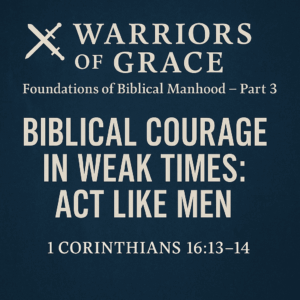⏱️ Estimated Reading Time: 7 min read
Five False Dichotomies
Which is your kind of preaching—expository or relevant? That is an example of a false dichotomy—a logical fallacy. False dichotomies operate under the assumption that there is no alternative, including no way to combine the qualities entailed in the so-called opposites.
One of Satan’s methods to mislead preachers is the false dichotomy. By setting two valid ideas against each other when they really belong together, the devil can use the appeal of one truth to attack another. If we swallow the bait, then the devil’s hook and line pull us away from faithful preaching and we lose both sides of the truth. Here are five myths—false dichotomies—that can catch preachers.
Myth #1: Preachers must be either exegetical lecturers or church motivators.
The exegetical lecturer is the pastoral version of a Bible commentary. The preacher is determined to avoid subjectivism; his sermon will be only the pure Word of God. Consequently, he rarely speaks from his heart to the hearts of his hearers, and they leave with full heads and withered souls.
Offended by the barrenness of that approach, the church motivator seeks not to inform but to transform by convincing people to adopt certain courses of action or programs. However, though he may lace his messages with Bible quotations, he sounds more like a motivational speaker or even a cheerleader than a messenger of God.
The faithful preacher takes the best from both sides of this dichotomy, for he strives—with the Spirit’s blessing—to have his expositions of the Holy Scriptures burn as fuel inflaming the church to holy affection and action.
Myth #2: Preachers must be either spiritual directors or doctrinal instructors.
The spiritual director—a fatherly figure—doles out specific advice to his children in the Lord. His mouth is full of wise counsel and practical directions, but he does not bother much with lofty doctrines of the faith such as the Trinity, the holiness of God, or Christ’s atoning work.
The doctrinal teacher—knowing how shallow Christians can be if they do not know what they believe—thoroughly explains the system of Christian faith revealed in the Holy Scriptures. However, he says little about application, leaving it to the Holy Spirit to apply the general principles of God’s Word to each individual’s life.
In reality, we must avoid both extremes, since “All Scripture . . . is profitable for teaching, for reproof, for correction, and for training in righteousness” (2 Tim. 3:16). The faithful preacher must have his eyes on Christ as revealed in the doctrines of the Bible and his feet on the ground to apply that doctrine to the needs and lives of his hearers.
Let God’s Word shape your sermons into preaching that is faithful to Scripture and relevant to your hearer.
Myth #3: Preachers must be either verse-by-verse expositors or textual preachers.
Another false dichotomy is set up when we insist that the only way to expound the Scriptures is by preaching through a book of the Bible one verse at a time. Sadly, the verse-by-verse expositor may be so chained to his method that he will not depart from it to address a crying need in the congregation’s life.
The textual preacher is free from such fetters, for he can choose any text he thinks best—so long as his sermon is an exposition of Scripture. However, he may be so free that he does not preach the whole counsel of God in a biblically balanced manner, but harps on his favorite texts and themes.
Both approaches to sermons have been used effectively by faithful preachers in the past. It is wise both to preach through books of the Bible and to preach textually as specific needs for teaching, ethical direction, and comfort arise.
Myth #4: Preachers must be either storytellers or pulpit orators.
The storyteller understands that much of the Bible is narrative and that people connect with stories in a way that is very moving. His reliance on biblical narrative and extra-biblical illustrations steers his preaching away from clear statements of doctrinal truth.
The pulpit orator constructs his sermons with an introduction, 2–4 logically argued propositions or points, and a conclusion. He preaches best from Romans but is not quite sure what to do with David and Goliath.
The fact is that the Bible comes to us in a variety of literary genres and styles, which commends flexibility in our methods of preaching. The storyteller needs to remember that substantial content, logical clarity, and practical application are vitally important to effective storytelling; and the pulpit orator must be creative and imaginative in his presentation of doctrinal truth if he wants to do more for his hearers than inform their minds. When preaching narrative, it is often best to retell the story in a way that draws your hearers into it and helps them see its doctrinal and practical applications. Shorter illustrations are helpful even in sermons with a more exegetical and theological outline. However, all preaching should aim to communicate vital doctrine and press home specific applications.
Myth #5: Preachers must be either piercing convincers or positive attracters.
The piercing convincer presses upon the conscience, the guilt and evil of sin together with the terror of divine judgment. He understands that sinners must see their great need before they will embrace the Savior. However, he may so insist upon conviction of sin that his congregation dwells in bondage and fear—even after conversion.
The positive attracter believes that it glorifies God for his people to rejoice in the Lord always. He wants his sermons to be always full of hope, to the point of extending hope to those who are without Christ and have no hope. He spends his time trying to persuade such people that they are Christians, when they are not. His feel-good messages may draw a crowd, but not make disciples of Jesus Christ.
Yet both sides of this dichotomy contain some truth, for faithful preaching will move people to sorrow for their sins, lead them to joyful deliverance through faith in Christ, and guide them in showing thankfulness to God by obeying His commands.
What Is Your Preaching Like?
As you look over these five dichotomies, which extremes do you find most attractive and which most repulsive? Beware of letting the devil drive you from one extreme to another. Don’t believe these are absolute dichotomies.
Instead, let God’s Word shape your sermons into preaching that is faithful to Scripture and relevant to your hearers; rich in doctrine and rife with practical application; drawn from every part of Scripture, and true to the whole of Scripture; as varied in method and style as the Scriptures are, yet always presented with “logic on fire”—that is, clear and passionate communication of the truth of God.
Otherwise, you have fallen into one of the myths of false dichotomies, and your preaching will lack—in one way or another—some vital element or nutrient essential to the health of your flock.
This is a guest article by Joel Beeke, author of Reformed Preaching: Proclaiming God’s Word from the Heart of the Preacher to the Heart of His People. This post originally appeared on crossway.org; used with permission.



